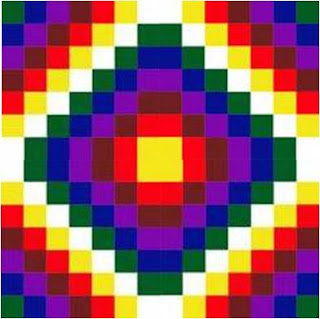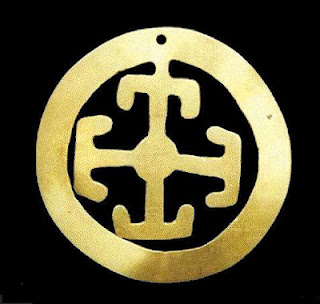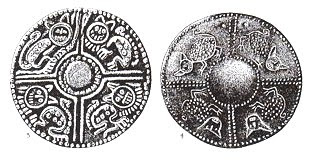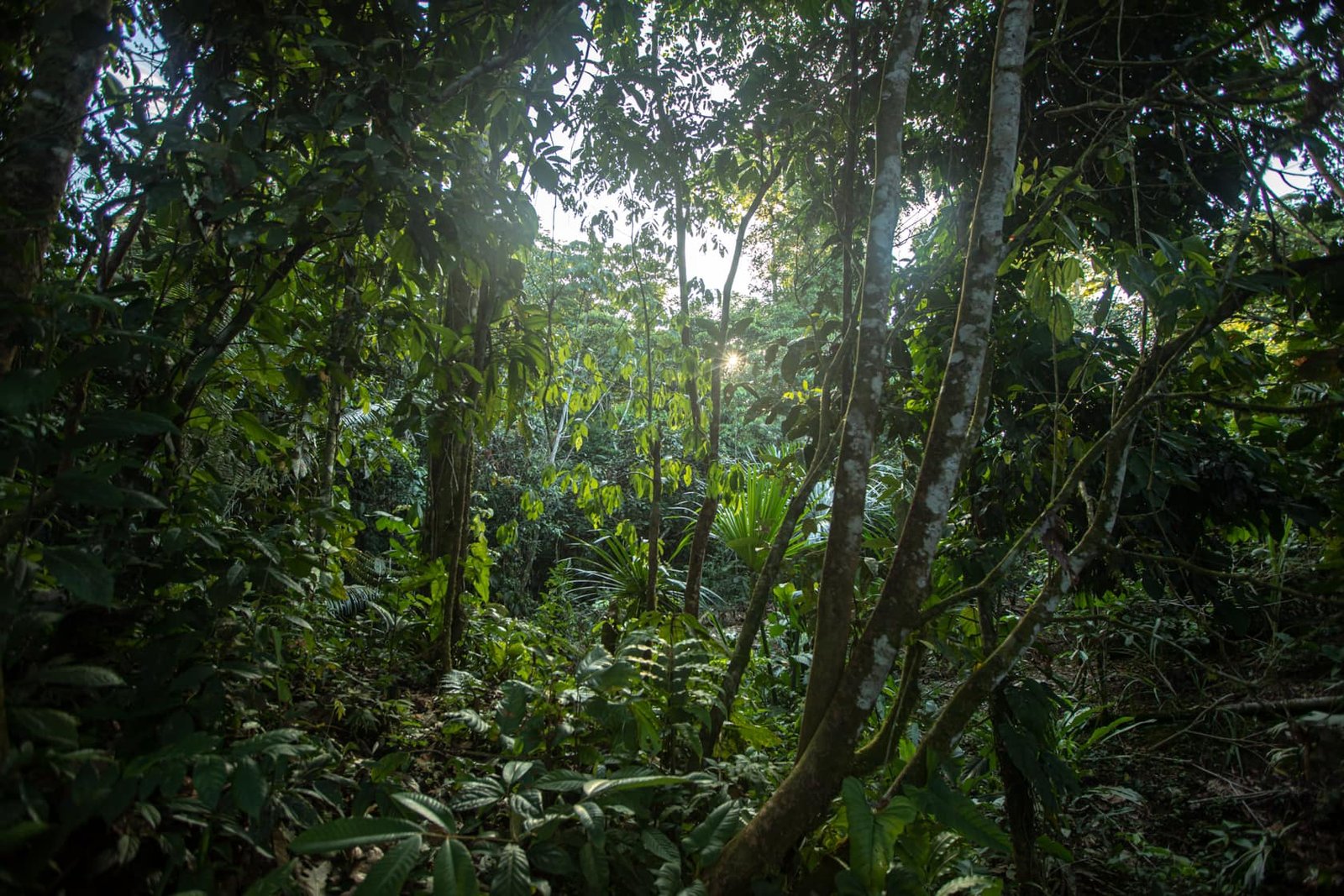 |
| Wiphala, flag of the Andean peoples. Chakana fractal |
Chakana or chaka hanan means “bridge to the top”. It is the name of the Southern Cross constellation, and constitutes the synthesis
of the Andean worldview.
Meaning of the Chacana or Andean Cross
From the Andean perspective, the chakana is the representation of a concept that has multiple levels of complexity according to its use. The chakana or chaka hanan means “bridge to the top”. It is the name of the constellation of the Southern Cross, and constitutes the synthesis of the Andean worldview. It is also an astronomical concept linked to the seasons of the year.
Juan de Santa Cruz Pachacuti Yamqui Salcamaygua, chronicler, in his “Chronicle of the Relation of Antiquities of this Kingdom of Pirú” drew and inserted an engraving on the Andean worldview, which was found on the High Altar of the Temple of Coricancha in Cuzco, which he called Chakana, the bridge or ladder that allowed the Andean man to maintain his latent union with the cosmos.
“The Andean cross is the square cross that we carry around,” say the villagers. In Cuenca, this cross appears in February over Turi, it is a cross of stars that remains during the night, turns south a little, but at five in the morning it disappears and comes out again at dusk, says taita Yaku Samay, who has closely followed the movements of the cross of stars, and for that reason knows that there are times when this cross also comes out at ten at night.
 |
| Symbol of the Kitu-Karamki cosmogony, representing the center as a living space and the distribution from the social, economic, political, and spiritual point of view |
“This cross remains in the sky turning towards the south,” say the taitas, and point out that it is very different from the Catholic cross; a Christian symbol that is longer towards the bottom, which arrived with the Spanish conquest and based on this cross, the Europeans began a process of evangelization of the grandparents.
The interpretation of the chakana
Subject to various interpretations and making the basic structure left by the chronicler Yamqui Salcamaygua compatible with the behavior of the Andean man, the most accepted conclusions about the figure of the chakana are multiple; among them it stands out that: the chakana (bridge or crossing) appears at the intersection or at the transition point of the lines drawn from top to bottom or vice versa, vertically, and from left to right or vice versa, horizontally.
There would be two “sacred spaces” that oppose each other: the first, of vertical projection, divided into a masculine half and a feminine half; the second, of horizontal projection, divided into a half of the “celestial beings” and the other half of the “earthly and subterranean” beings.
The top-down orientation would have masculine connotations, and the bottom-up orientation would have feminine connotations. The chakana has the shape of an X, the diagonals connect the 4 corners of the “house”, that is, of the universe. The chakana is the Andean symbol of the relationality of the whole.
The vertical line expresses the relational opposition of the correspondence between the large and the small: “such in the large, such in the small.” The space above the horizontal line is the Hanaq Pacha (upper world, “upper stratum”). The space below the horizontal line is the Kay Pacha (this world). The communication channels that exist between the two worlds are the springs, lagoons, mountains.
There are multiple relationships of correspondence and complementarity in it, such as between the roof and the floor, between the sun and the fire, between day and night and between man and woman, which indicate the path to follow to discover that its construction is not only based on utilitarian reasons. All the objects in it have a reason for being, none is superfluous.
 |
| Symbolism of possible chakanas, found on breastplates of the Cañari culture of Ecuador, registered in the book The Gold of Cuenca, Ecuador, by Marshall Saville |
Religious syncretism between the Catholic cross and the Chakana
Venerating the Catholic cross is part of the religious syncretism that existed in the peoples of America, therefore on May 3rd, some indigenous communities celebrate and venerate the feast of the Cross. It is said that the invention of the “Holy Cross” has been commemorated since ancient times. In Spain, it appears in all the Mozarabic calendars and liturgical sources, linking it to the story of the discovery by Saint Helena of the authentic Cross of Christ.
In Andean villages, paying tribute to the Catholic cross is like trying to find one’s own path. “If you get lost on the road, you can’t continue; therefore you go back to the beginning to find out which is the original path,” says Yaku, explaining that the third of May has no relation between the cosmos and the presence of the Southern Cross, a situation that is evident in the four raymis that are celebrated during the year. For Samuel Lojano, another community leader, the Andean cross is a thousand-year-old symbol of Hatun Taita and Hatun Hama (the great father and the great mother) that was expressed in America from the beginning of life and that is why all Andean villages have it as one of their symbols of devotion and through it they watch over the respect for Pachamama.
The Andean cross is an image that invites us to live in harmony with nature, to respect water and everything that Mother Earth does to provide food for her children. “The chacana represents our experience, and how we must preserve Mother Nature for our children, grandchildren and for all those who come,” says Samuel. It is worth seeing how the Taitas hang an Andean cross around their necks. Taita Yaku carved his own chacana in rosewood. It is a chacana that has a white part and a dark part, that is how it represents duality, whether it is good and evil, man and woman, etc.
It is a palm-sized cross with a shining sun in the center. This sun is the symbol of Taita Inti or Father Sun, the physical father who allows the existence of the entire planet. “Taita Sun is the husband of Mother Earth, the father who gives warmth to humanity,” say experts. “Without the sun there would be no light, no warmth, no photosynthesis, the sun gives calcium to human beings. Without the sun it would be the end of the earth, the planet that receives its light,” says Yaku. (BSG)-(Interculturality)
Investigation: The Mercury
You may also like….
![]()






